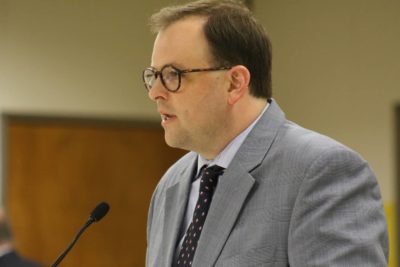More than seven months after Hurricane Matthew devastated individuals across eastern North Carolina, the state is still searching for funding to meet the needs of families and communities.
Hurricane Matthew’s statewide damage, according to estimates from the North Carolina Emergency Management Office, ended up costing three times more than what they originally thought — more than $4.5 billion. More than 82,000 households have registered for FEMA assistance.
The gap in original estimates and reality is largely because costs are often hard to estimate and much of the damage was not immediate, like problems with building infrastructure that did not become apparent until weeks or months later. So far, about $1.1 billion in relief funds have been distributed, either directly into individuals’ pockets or through various recovery mechanisms.
“The quick answer is we need more funding,” said Julia Jarema, public information officer for the emergency management office.
In December, the state legislature passed the Disaster Recovery Act, allocating about $200 million for the recovery from Hurricane Matthew’s damage in eastern N.C. and the aftermath of wildfires in the western part of the state.
Rep. Nelson Dollar, R-Wake, at the time, said this was only a first step with more money to come in a second phase in the 2017 legislative session. Rep. Chuck McGrady, R-Henderson, said he knew the numbers they were working with were preliminary estimates.
“We know we don’t have all the numbers right,” McGrady said in December. “We know there’s not enough money there.”
This legislative session, the Senate and House budgets set aside $150 million in disaster relief funding. According to the Senate budget, $80 million of the total $150 million would be used for the state’s match of federal assistance dollars, and $70 million was allocated for further assistance in recovery to areas under the Disaster Recovery Act which includes 49 counties. Legislators are now meeting to come up with a budget compromise which will include official funding levels.
After working with congressional leaders to put together a request for more relief funding from the federal government, Gov. Cooper expressed frustration that only one percent of the funding he requested was approved. Out of the $929 million requested, Congress and President Donald Trump approved $6.1 million.
In the unmet needs request, $245.5 million would have gone to housing repairs for homeowners, renters, and public housing. Since many affected properties are at risk of flooding again, $434 million would have been used for housing elevation, buyout, and reconstruction. Farmers not covered by the U.S. Department of Agriculture would have received $92.6 million to cover agricultural losses. Forty-three million dollars of the funds would have gone to repairing public facilities and preventative infrastructure for the event of future flooding. Small businesses — 691 of them — would have received $39 million for recovery. And $37 million would have gone to health services for survivors and repairs for health care facilities.
Gov. Cooper said he is continuing to fight for more assistance.
“Recovering from Hurricane Matthew will be a long-term process, and Gov. Cooper is continuing to work with state and federal officials to make sure communities get the resources they need to rebuild and that those resources get on the ground as quickly as possible,” said Noelle Talley, spokesperson for the governor. “We appreciate state legislators working with our office on this critical need.”
The denial of funding assistance comes after the state was approved for a $198 million grant in January for temporary housing, debris removal, relocating properties out of dangerous areas, repairing homes, businesses, and public facilities, and help for storm survivors buying new homes.
At the local level, communities and school districts are trying to confront needs day to day while waiting on support from state and federal sources.
Edgecombe County Public Schools Superintendent John Farrelly, wrote a letter to Gov. Cooper in March outlining the district’s highest needs before meeting with the governor. In the county, 3,147 residents had asked for some type of federal or state assistance by May 16.
The district’s most pressing need, according to the letter, is funding to cover transportation costs. Farrelly said the district will have to pay an additional $300,000 to bus in displaced students each day living in other counties, either with relatives or in hotels. For next school year, the district policy does not allow the extensive busing to continue, and families will have to provide their own or move to another school district. The same transportation issues have been apparent in Robeson County, another of the hardest hit areas in the state.
Farrelly also asked for legislation that maintains the district’s average daily membership (ADM) from the beginning of the school year. The count affects how much funding local school districts receive from the state, and it is in flux because of the hurricane. Many residents have not yet returned to their homes, and Farrelly said keeping the ADM at a constant rate for the next two years can provide the school system with some stability.
Lastly, Farrelly requested $460,778 to restore services for low-wealth and at-risk students. He said the hurricane highlighted many of the pre-existing needs of the student population.
Lauren Lampron, principal of Tarboro’s Pattillo Middle School which serves many students affected by the storm, said that although reactive support is needed, proactive measures could address larger issues in low-income areas of the state.
“When we look, in general, at just low-income areas, and what we know happens to kids in low-income areas in terms of … growing up with adverse childhood experiences, it would make sense to me that areas in low-income would be funded greater in terms of having more access to guidance counseling and mental health resources,” Lampron said.
Lampron said funding and policy around ensuring students come to school ready to learn — emotionally and cognitively — are needed.
“If they had additional support, in mental health, in guidance counseling, K-12, I think we’d be at a much greater space.”



